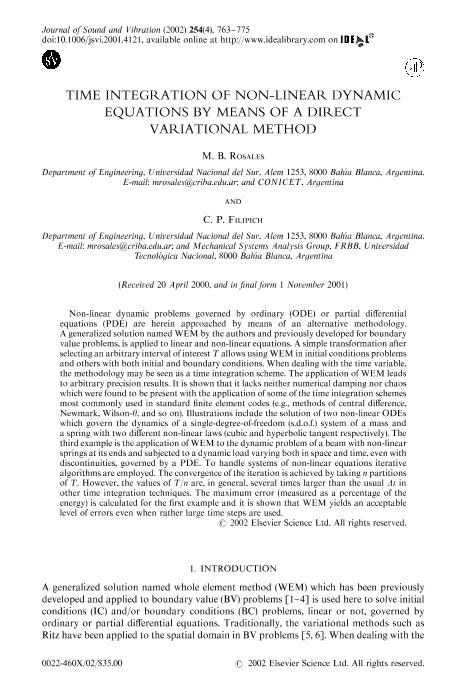Mostrar el registro sencillo del ítem
dc.contributor.author
Rosales, Marta Beatriz

dc.contributor.author
Filipich, Carlos Pedro

dc.date.available
2018-03-07T21:25:44Z
dc.date.issued
2002-07
dc.identifier.citation
Rosales, Marta Beatriz; Filipich, Carlos Pedro; Time integration of non-linear dynamic equations by means of a direct variational method; Academic Press Ltd - Elsevier Science Ltd; Journal of Sound and Vibration; 254; 4; 7-2002; 763-775
dc.identifier.issn
0022-460X
dc.identifier.uri
http://hdl.handle.net/11336/38229
dc.description.abstract
Non-linear dynamic problems governed by ordinary (ODE) or partial differential equations (PDE) are herein approached by means of an alternative methodology. A generalized solution named WEM by the authors and previously developed for boundary value problems, is applied to linear and non-linear equations. A simple transformation after selecting an arbitrary interval of interest T allows using WEM in initial conditions problems and others with both initial and boundary conditions. When dealing with the time variable, the methodology may be seen as a time integration scheme. The application of WEM leads to arbitrary precision results. It is shown that it lacks neither numerical damping nor chaos which were found to be present with the application of some of the time integration schemes most commonly used in standard finite element codes (e.g., methods of central difference, Newmark, Wilson-θ, and so on). Illustrations include the solution of two non-linear ODEs which govern the dynamics of a single-degree-of-freedom (s.d.o.f.) system of a mass and a spring with two different non-linear laws (cubic and hyperbolic tangent respectively). The third example is the application of WEM to the dynamic problem of a beam with non-linear springs at its ends and subjected to a dynamic load varying both in space and time, even with discontinuities, governed by a PDE. To handle systems of non-linear equations iterative algorithms are employed. The convergence of the iteration is achieved by taking n partitions of T. However, the values of T/n are, in general, several times larger than the usual Δt in other time integration techniques. The maximum error (measured as a percentage of the energy) is calculated for the first example and it is shown that WEM yields an acceptable level of errors even when rather large time steps are used.
dc.format
application/pdf
dc.language.iso
eng
dc.publisher
Academic Press Ltd - Elsevier Science Ltd

dc.rights
info:eu-repo/semantics/openAccess
dc.rights.uri
https://creativecommons.org/licenses/by-nc-nd/2.5/ar/
dc.subject
Time Integration Technique
dc.subject
Direct Method
dc.subject
Dynamic Problem
dc.subject
Initial Conditions-Boundary Value Problems
dc.subject.classification
Astronomía

dc.subject.classification
Ciencias Físicas

dc.subject.classification
CIENCIAS NATURALES Y EXACTAS

dc.title
Time integration of non-linear dynamic equations by means of a direct variational method
dc.type
info:eu-repo/semantics/article
dc.type
info:ar-repo/semantics/artículo
dc.type
info:eu-repo/semantics/publishedVersion
dc.date.updated
2018-03-07T17:59:12Z
dc.journal.volume
254
dc.journal.number
4
dc.journal.pagination
763-775
dc.journal.pais
Estados Unidos

dc.description.fil
Fil: Rosales, Marta Beatriz. Universidad Nacional del Sur. Departamento de Ingeniería; Argentina. Consejo Nacional de Investigaciones Científicas y Técnicas; Argentina
dc.description.fil
Fil: Filipich, Carlos Pedro. Universidad Nacional del Sur. Departamento de Ingeniería; Argentina
dc.journal.title
Journal of Sound and Vibration

dc.relation.alternativeid
info:eu-repo/semantics/altIdentifier/doi/http://dx.doi.org/10.1006/jsvi.2001.4121
dc.relation.alternativeid
info:eu-repo/semantics/altIdentifier/url/https://www.sciencedirect.com/science/article/pii/S0022460X01941215
Archivos asociados
